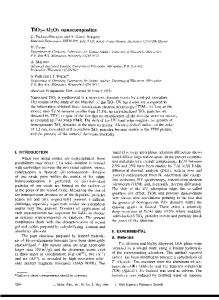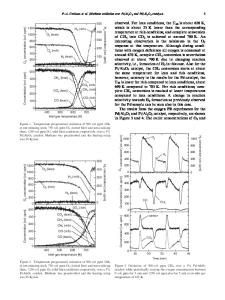Effects of Al 2 O 3 Type on Activity of Al 2 O 3 -Supported Rh Catalysts in Single-Walled Carbon Nanotubes Growth by CVD
- PDF / 349,386 Bytes
- 7 Pages / 432 x 648 pts Page_size
- 21 Downloads / 283 Views
Effects of Al2O3 Type on Activity of Al2O3-Supported Rh Catalysts in Single-Walled Carbon Nanotubes Growth by CVD Hoshimitsu Kiribayashi1, Takayuki Fujii1, Takahiro Saida2, Shigeya Naritsuka1 and Takahiro Maruyama2 1
Department of Materials Science and Engineering, Meijo University, 1-501 Shiogamaguchi, Tempaku, Nagoya 468-8502, Japan 2 Department of Applied Chemistry, Meijo University, 1-501 Shiogamaguchi, Tempaku, Nagoya 468-8502, Japan ABSTRACT We carried out single-walled carbon nanotube (SWCNT) growth using a Rh catalyst on Al2O3 buffer layers that were prepared by three different methods based on electron beam (EB) evaporation: native oxidation of Al layer deposited by EB ([EB(Al)+NO]-Al2O3 layer); thermal oxidation of Al layer deposited by EB ([EB(Al)+TO]-Al2O3 layer); EB deposition of Al2O3 layer ([EB(Al2O3)]-Al2O3 layer). SWCNT yield was the largest for the [EB(Al2O3)]-Al2O3 layer, while SWCNTs were not grown on the [EB(Al)+NO]- Al2O3 layer. Transmission electron spectroscopy showed that most of Rh particle sizes were distributed between 1.0 and 2.6 nm on the [EB(Al)+NO]- Al2O3 and [EB(Al2O3)]- Al2O3 layers, while they were distributed between 1.8 and 4.2 nm on the [EB(Al)+TO]- Al2O3 layer. This result indicates that surface migration of Rh catalysts was suppressed on the [EB(Al2O3)]- Al2O3 layer, resulting in the largest SWCNT yield. On the other hand, enlargement of Rh catalyst particles occurred on the [EB(Al)+TO]Al2O3 layer, leading to the reduction of SWCNT yield. Taking into account our previous study, inward diffusion of Rh catalysts into the Al2O3 buffer layer inhibited SWCNT growth on the [EB(Al)+NO]- Al2O3 layer, although enlargement of Rh particle size was suppressed. We also carried out ultra-violet photoemission measurements for Rh catalysts on the [EB(Al)+TO]Al2O3 and [EB(Al2O3)]- Al2O3 layers and investigated the electronic states of Rh catalysts on them. INTRODUCTION
Single-walled carbon nanotubes (SWCNTs) [1] have tremendous properties such as ballistic transport [2], high carrier mobility [3], and high current-carrying density [4]. Therefore, they are anticipated for various applications in future nanoelectronics devices [5-8]. At present, catalyst-assisted chemical vapor deposition (CVD) are widely used for synthesizing SWCNTs [9-12]. In CVD growth, metal nanoparticles serve as a catalyst to assist carbon feedstock cracking and facilitate nucleation of the SWCNTs. To enhance the catalytic activity, an amorphous Al2O3 buffer layer has been widely used as a supporting material for the catalysts particles. So far, several group reported SWCNT growth using Fe catalysts on Al2O3 buffer layers [11-13]. We also showed the increase of SWCNT yield using Al2O3 buffer layers in CVD growth using Co catalysts and attained SWCNT growth at 400 ºC [14]. Recently, we reported the effect of fabrication method of the Al2O3 buffer layers on SWCNT yield in CVD growth using Rh catalysts [15]. Rh has a low dissociation barrier for an ethanol molecules [16, 17] and is a beneficial catalyst for SWCNT growth at











